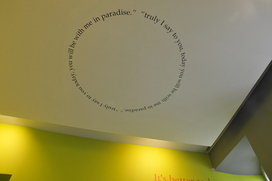Douglas Gordon
dal 15/2/2010 al 15/5/2010
Segnalato da
15/2/2010
Douglas Gordon
Tate Britain, London
The artist has been invited to create an installation of text works in the Octagon space at Tate Britain, which adjoins the themed collection display, Art and the Sublime, in Gallery 9. Both displays form part of The Sublime Object: Nature, Art and Language, a research project funded by the Arts and Humanities Research Council, under the Landscape and Environment Programme.

Douglas Gordon has been invited to create an installation of text works in the Octagon space at Tate Britain, which adjoins the themed collection display, Art and the Sublime, in Gallery 9.
Both displays form part of The Sublime Object: Nature, Art and Language, a research project funded by the Arts and Humanities Research Council, under the Landscape and Environment Programme.
Gordon’s installation will be on view from 16 February to 16 May 2010.
The Sublime in Crisis:Terror, Torment and Transcendence
A display devised by curator Christine Riding.
This display of paintings from the eighteenth to the early twentieth century explores how a particular group of ideas and artistic practices, which emerged between 1760 and 1830, survived and transformed in various, often elusive, ways over subsequent decades.
Scholars and philosophers have debated the term ‘sublime’ for centuries. In aesthetics it is usually defined as having the quality of greatness or magnitude - physical, moral, intellectual, metaphysical, aesthetic or spiritual - which temporarily overwhelms the viewer’s ability to perceive or comprehend. The best-known theory published in Britain is Edmund Burke’s A Philosophical Enquiry into the Origin of Our Ideas of the Sublime and Beautiful, 1757. He was the first to argue that the beautiful and the sublime were distinct from each other, like light and dark, although he allowed that both could be experienced as pleasurable, because of the intense emotions provoked by the vast, magnificent or terrible.
During the eighteenth and early nineteenth centuries, the sublime was associated in particular with the immensity or turbulence of Nature. In Western art, ‘sublime’ landscapes and seascapes can be described as a distinct genre, engaging with subjects such as towering mountain ranges, deep chasms, threatening storms, volcanic eruptions, or avalanches which, if actually experienced, would endanger life. Other themes related to the vogue for Gothic fiction or terrifying events described in epic literature or the Bible. Artists like JMW Turner and John Martin were celebrated for their apocalyptic visions, and their original audiences may have felt ‘transported’ by such images
Since paintings are, by their very nature, representations and often restricted by scale, some commentators have questioned whether we can really experience or appreciate them as sublime. This is especially pertinent when the treatment of a sublime theme becomes conventionalised, theatrical or clichéd.
Image: Douglas Gordon, Collection Lambert, Avignon 2008 © Courtesy of the artist. Photo: Frederik Pedersen for Douglas Gordon
For further press information please contact Helen Beeckmans/Louise Butler
Call 020 7887 8731/8732/4939 Email pressoffice@tate.org.uk
Tate Britain
Millbank, London
Opening hours:
Tate Britain is open daily, 10.00-17.50
Exhibitions 10.00-17.40 (last admission 17.00)
Admission £10 (£9, £8 concessions) Free for Tate Members





